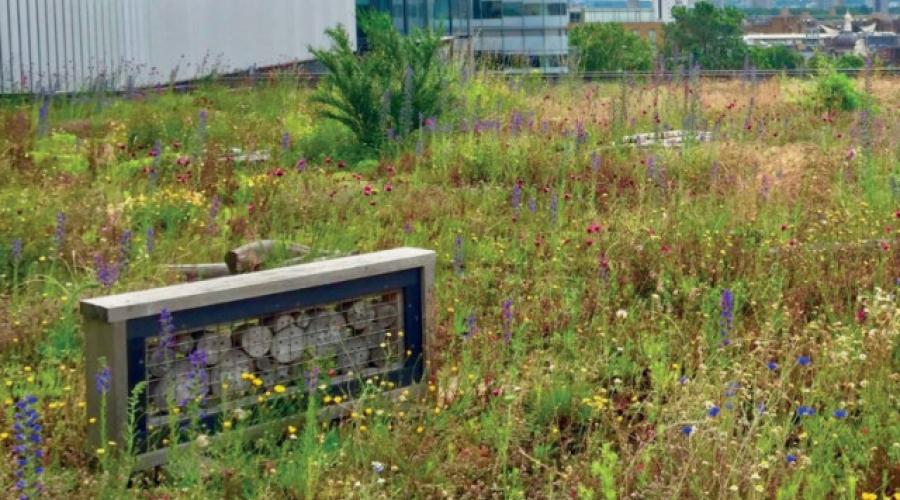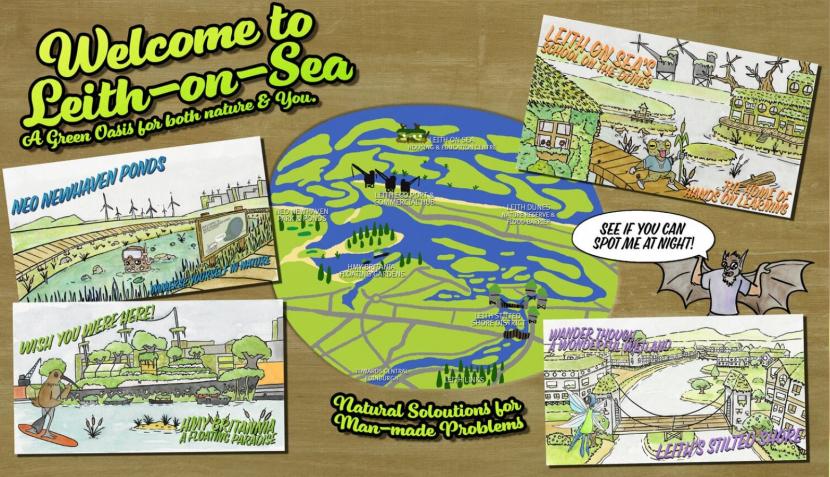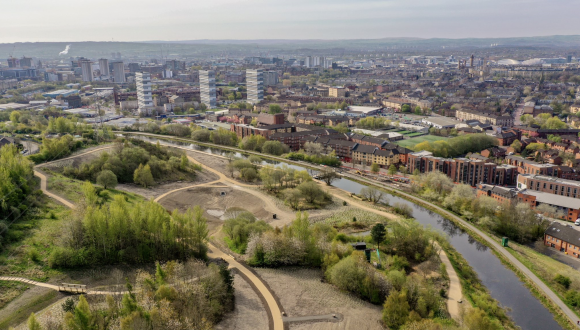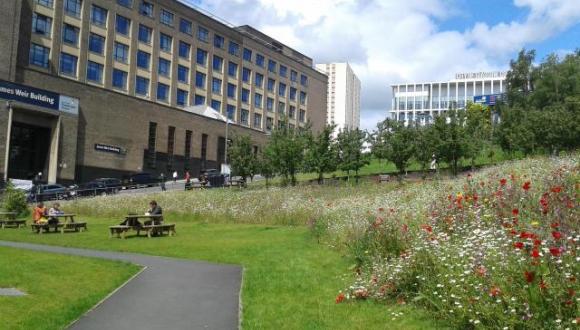
A vision for Leith
One of NatureScot's ecologists, Abi Gardner, has been talking about working with a young artist as part of the Edinburgh's Future Green Spaces Exhibition, coordinated by the British Ecological Society. Part of the capital city's Science Festival the collaboration focussed on the newly named 'Leith-on-Sea', and explored what the area could look like if it used nature-based solutions to adapt to effects of climate change.
Can you summarise the artwork and your vision for a green future?
Our artwork depicts a future version of coastal Leith, embracing the need to adapt to the effects of climate change and integrate the blue and green into the area. Using dunes as coastal defences, and sustainable drainage elements such as green roofs and walls, Leith has become an urban wetland oasis bringing biodiversity and people to the heart of where people live, work and play.
Our tourist board shows the newly designed areas of Leith, while incorporating the recognisable landmarks such as the Water of Leith, the docks, and HMY Britannia. We also included (as town mascots) the biodiversity that would be drawn to the area, including my personal favourite the paddle-boarding Curlew.

What have you learnt whilst working with an artist to create visions of a green future?
It's been a great experience to explore nature-based solutions, a concept dominated by academics, policy makers, and practitioners, with an artist in a creative way. This creative process allowed us to explore our own and each other’s work and relationship to nature, then the wider issues and problems we're passionate about, before looking to the solutions, all within a few short weeks. It was interesting to see how someone outside of the environmental sector connected with their local nature and how this, along with the science, shaped how we designed our future greenspace vision.
Tell us about the nature-based solutions in your artwork?
As a coastal location, Leith will experience continuous pressures from sea level rise and storms leading to an increase in coastal erosion and flooding. We've depicted a new dune system which will not only help protect the coastline from erosion and help prevent flooding of built areas, but also provide a habitat for new species and a greenspace for people to enjoy.
Urban green infrastructure elements are also present in our future Leith. Green roofs, living walls, swales and ponds help slow down water in times of intense rainfall. This prevents water entering our sewage system or the Water of Leith too quickly and overwhelming it, preventing surface flooding. Parks and other greenspaces that are left without development can be used to purposely be flooded in storm events. This prevents flooding in areas that you particularly don't want flooding, damaging infrastructure like homes and roads. When not flooded, these areas again provide habitat for wildlife and places for people to spend time in. Encouraging these spaces to be wild, through actions such as planting wildflowers of different species, is particularly great for our wildlife including the pollinators on which we rely.
While shown in our fantastical future green space, these nature-based solutions are already being successfully implemented across Scotland and beyond.
What role do you think green spaces have in working towards tackling the climate crisis and providing a green future?
Globally, nature-based solutions can provide one-third of the cost-effective climate mitigation needed between now and 2030 to stabilise warming to below 2°C. They are likely to have an even larger role in our adaptation to climate change. Blue and green features also support significantly higher levels of biodiversity than constructed ‘grey’ infrastructure whilst delivering important additional environmental, social and economic benefits.
Green and blue spaces can provide daily contact with nature for those living and working in urban areas. Building a strong connection with nature has shown to lead people to taking pro-environmental and pro-nature conservation actions such as using green energy, buying seasonal produce, rewilding gardens and taking part in environmental volunteering. Well implemented nature-based solutions are co-designed, co-created and co-managed by the local community leading to increased sense of ownership and care for our local greenspaces. Ensuring that everyone is able to build this relationship with nature will play a huge part in a Just Transition to a net-zero, nature-rich future.
Notes:
This artwork was part of the Edinburgh’s Future Green Spaces Exhibition, organised by the British Ecological Society, SMASH UK and the Edinburgh Science Festival. While the Edinburgh Science Festival 2021 has come to an end, the artwork, along with others, can still be viewed in the virtual exhibition pages.






